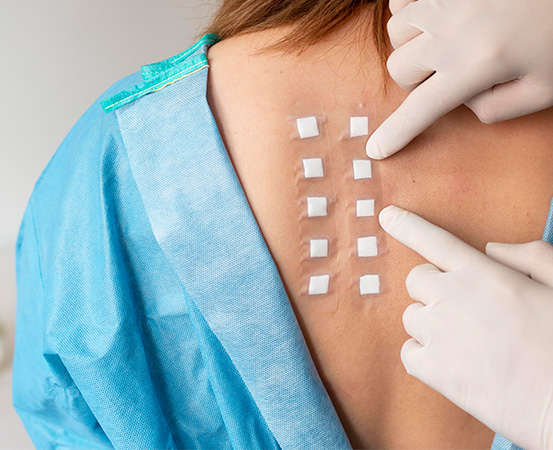
In March 2023, a bride-to-be from Hassan, Karnataka, landed up in the ICU after trying on bridal makeup. The woman, who had hoped to get a makeover for her special day, ended up having a severe allergic reaction, facing nightmarish consequences in the form of a swollen, disfigured face, according to media reports. The fiasco could have possibly been avoided if she had done a patch test to check for any allergies prior to the wedding.
“Reactions to cosmetics and personal care products are among the most common skin problems that people consult an allergist for,” says Dr Sujatha Ramesh, consultant, pediatric allergy and immunology at Manipal Hospital, Yeshwanthpur, Bangalore. While such products often come with a patch test warning, most people turn a blind eye towards it.
Patch test: Why is it important?
As per a 2023 survey published on the official website of the Environmental Working Group, an American activist organization, an average adult uses around 12 personal care products a day. According to the study, an adult female uses 13 such products, while a male uses 11. Simply put, one gets exposed to 168 chemicals per day.
Personal care products encompass a wide range of items, including cosmetics, cleansing agents, hair care and hair removal products, skincare products, perfumes and deodorants, hair dyes, etc. “They contain ingredients like fragrances, coloring agents and preservatives, which are common allergens that can potentially cause reactions,” says Dr Smriti Naswa Singh, consultant dermatologist and fellow pediatric dermatologist, Fortis Hospital, Mulund, Mumbai. She says that doing a patch test before trying a product for the first time can help identify if you’re allergic to it, preventing the possibility of an adverse reaction.
How to carry out a patch test?
There are two types of patch tests: one is the at-home patch test, while the other is a professional patch test done by a medical practitioner. “The at-home patch test involves applying a small amount of the product behind the ear or inner arm to check for any adverse reactions,” shares Dr Singh.
“A professional patch test is performed by exposing the individual to a set of suspected reagents like fragrance mixes, preservatives, emollients and other additives that are carefully chosen based on their case history. These ingredients are applied on their upper back and covered with a patch. They are then examined after 24, 48 and 72 hours,” explains Dr Sujatha.
“If the area becomes red, itchy or swelled up, or there’s blister formation accompanied by oozing, it indicates that the ingredients in the product do not suit the skin,” says Dr Singh.
The reactions can manifest as early or late hypersensitivity. “In early hypersensitivity, the reactions are seen within 24 hours, while in the case of late hypersensitivity, they may take up to seven days to manifest,” adds Dr Singh.
Since patch tests are done using a small amount of the product, the reactions are restricted to the skin in the form of allergic contact dermatitis or irritant dermatitis. “Not all reactions are allergic. Some may indicate an irritant response known as irritant contact dermatitis. The manifestations include a stinging or burning sensation and a contact rash,” emphasizes Dr Sujatha. Professional patch tests help identify if the reaction is caused by an allergy or irritation. It also helps detect the specific ingredient causing the allergy.
Patch test: Ignore at your own risk
Dr Singh recounts a case where a Mumbai-based woman in her 20s had a destination wedding and consulted the local makeup artist for her bridal makeover. “The makeup artist may have used products that the woman wasn’t familiar with. A few hours after applying the makeup, her skin broke out into blisters that were oozing,” she recalls. “We also see many people having allergic reactions to mehndi (henna), where they develop severe itching.” She opines that despite such repeated mishaps, the ignorance surrounding patch tests looms large, as they’re not a common practice in salons or among cosmetologists.
Dr Sujatha advises those sensitive to skin reactions to read the labels before trying on products. “One should be wary of products marketed as hypoallergenic, fragrance-free or natural, as they can still contain masking fragrances, preservatives and excipients,” she cautions.
Takeaways
- A patch test, which helps detect unsuitable skin products for an individual, can play a vital role in preventing adverse consequences.
- Patch tests are of two types: at-home patch tests and those done by a medical practitioner.
- At-home patch tests involve applying a small amount of the product behind the ear or on the inner arm to look for any allergy or irritation.
- A patch test done by a medical practitioner helps detect reactions through the application of small amounts of suspected ingredients on an individual’s upper back and covering them with patches.
- The test should not be overlooked. In addition, it’s essential to go through the labels before trying on products to identify any ingredient that might cause a reaction.

















